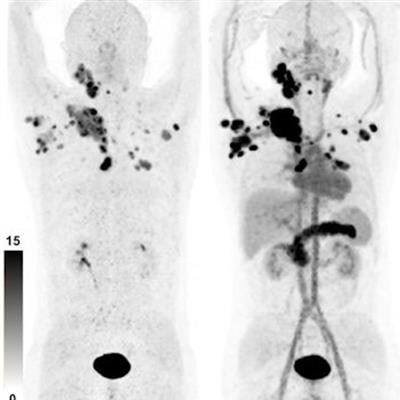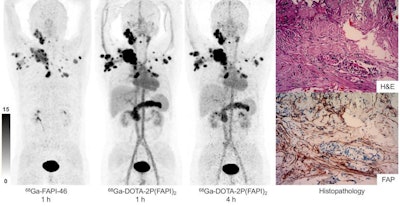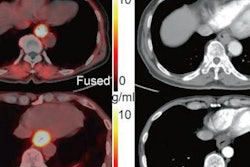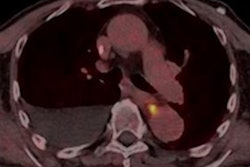
Chinese researchers have fine-tuned a PET radiotracer so that it detects cancer twice as effectively as its precursors, according to a study published September 23 in the Journal of Nuclear Medicine.
Gallium-68 (Ga-68)-labeled fibroblast activation protein inhibitors (FAPI) are experimental PET tracers that have shown promising results in tumor diagnosis, yet the molecules have relatively short tumor-retention time for radionuclide therapy applications, according to the authors. The researchers designed and created a new FAPI tracer in lab studies and then tested it in a small number of patients.
"The tumor uptake of Ga-68 DOTA-2P(FAPI)2 was approximately two-fold stronger than that of Ga-68 FAPI-46 in [patient-derived xenografts], while the healthy organs showed low tracer uptake and fast body clearance," wrote first authors Drs. Liang Zhao and Jiayang Fan of the First Affiliated Hospital of Xiamen University.
Fibroblast activation protein (FAP) is overexpressed in cancer, and researchers suspect it is an essential component driving the growth of tumors. Experimental FAP-targeted molecular imaging agents, such as FAPI-04 and FAPI-46, have shown promising results in tumor diagnosis.
However, these molecules are washed out of the body relatively quickly, which makes it more difficult to use them to see whether treatments are effective, according to the authors.
In this study, the researchers designed and synthesized a new FAPI radiotracer (Ga-68 DOTA-2P[FAPI]2) by adding an additional molecule to the compound that allows it to bind longer to its target, the FAPI protein in tumors. They hypothesized the new tracer would be more effective than any monomeric analogs, such as Ga-68 FAPI-46, in terms of tumor uptake and tumor-retention time.
After synthesizing Ga-68 DOTA-2P(FAPI)2, they tested it in mice and found the tumor uptake of Ga-68 DOTA-2P(FAPI)2 was significantly higher than that of Ga-68 FAPI-46. They then determined the most effective dose in three healthy patients.
Finally, the researchers tested both Ga-68 FAPI-46 and the new Ga-68 DOTA-2P(FAPI)2 tracer on PET/CT scans in three patients. Scans were performed after 60 minutes of intravenous administration. One patient was diagnosed with bone metastases after chemoradiotherapy and immunotherapy, one had wild diffuse lymph node metastases after total thyroidectomy and multiple cycles of radioiodine treatment, and the third patient was diagnosed with treatment-naive hepatocellular carcinoma.
 Ga-68 FAPI-46, one hour after injection, and Ga-68 DOTA-2P (FAPI)2, one and four hours after injection, in a patient with metastatic thyroid cancer. Hematoxylin and eosin (H&E) staining and FAP immunohistochemistry staining showed high FAP expression in the tumor stroma (original magnification, ×100). Image courtesy of the Journal of Nuclear Medicine.
Ga-68 FAPI-46, one hour after injection, and Ga-68 DOTA-2P (FAPI)2, one and four hours after injection, in a patient with metastatic thyroid cancer. Hematoxylin and eosin (H&E) staining and FAP immunohistochemistry staining showed high FAP expression in the tumor stroma (original magnification, ×100). Image courtesy of the Journal of Nuclear Medicine.PET/CT scans revealed higher intratumoral uptake of Ga-68 DOTA-2P(FAPI)2 than that of Ga-68 FAPI-46 in all tumor lesions (SUVmax: 8.1 vs. 1.7).
"DOTA-2P(FAPI)2 labeling with Ga-68 demonstrated favorable data in cells, mice, and patients," the researchers wrote.
The authors noted that although there has been a burst of preclinical and clinical research on FAPI variants, two main hurdles remain: improving the tumor retention time and finding the appropriate preclinical models.
Significantly, in this study, tumor uptake in most lesions was significantly higher with Ga-68 DOTA-2P(FAPI)2 than with Ga-68 FAPI-46, which led to the visualization of primary lesions and metastases more clearly, the authors stated.
"Further work to optimize the pharmacokinetics of DOTA-2P(FAPI)2 and evaluate its anti-tumor efficacy after labeling with therapeutic isotopes should be envisaged," the researchers concluded.





















